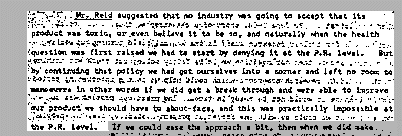Act II, Scene 1: Truth and Consequences

"Mr. Reid suggested that no industry was going to accept
that its product was toxic or even believe it to be so, and naturally when
the health question was first raised, we had to start by denying it at the
P.R. level. But by continuing that policy we had got ourselves into a corner
and left no room to maneuver. In other words, if we did get a breakthrough
and were able to improve our product we should have to about-face and this
was practically impossible at the P.R. level."
Minutes of BAT's 1962 Southampton
conference, 1102.01, p. 47. W.V Reid, of Brown & Williamson's Australian
affiliate.
By the early seventies, there was a lot of research but not much good news.
It turned out there were not just one or two carcinogenic components in
cigarette smoke, but dozens, and they could not be removed or filtered out
(Battelle
report, 1152.01). Attempts to make synthetic cigarettes from
non-tobacco materials, such as something called "Batflake," failed
miserably. (A
Comparative Inhalation Toxicity Study. 1127.01) It seemed that
anything that was burned and inhaled was unhealthy, including quite possibly
the additives that the industry had been depending on for many years.
Brown & Williamson began to realize it had wandered into a trap. It
had spent more than a decade strenuously denying that cigarettes caused
disease while spending a fortune to find out just the opposite. It could
no longer claim it didn't know better. Now, if the industry revealed what
it knew, it was vulnerable to all sorts of attack. Continuing to conceal
the truth was an enormous legal liability.
In the end, the cigarette companies worked just as hard on a cover-up, which
lasted decades, as they had on the science that made it necessary. (See
1165.01
and 1184.02)



|
|